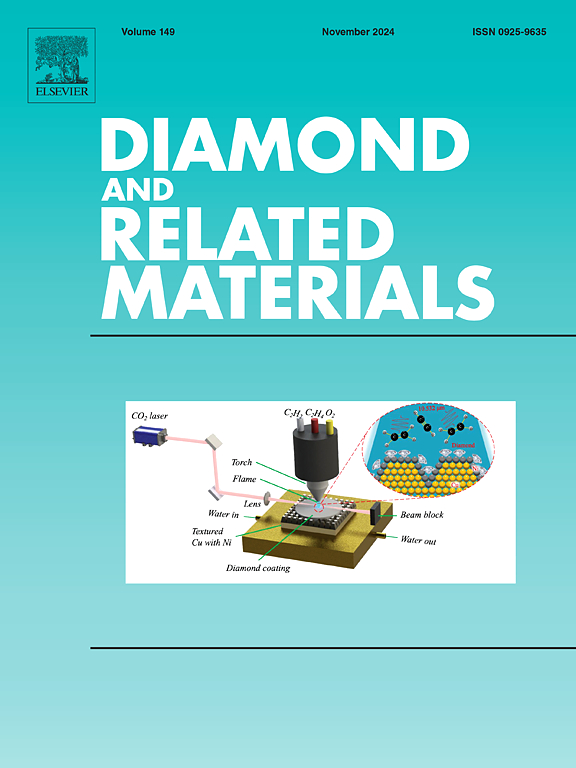Two types of stimulated emission in HPHT diamond with a high concentration of NV centers
IF 4.3
3区 材料科学
Q2 MATERIALS SCIENCE, COATINGS & FILMS
引用次数: 0
Abstract
The paper presents the results of experimental observation of two types of stimulated emission (SE) under pulsed laser pumping at 532 nm in diamond with NV centers. A comprehensive spectroscopic characterization of multisectorial HPHT diamond plate was performed. At low pumping power, the stimulated emission from NV¯ centers was recorded as a broad (≥80 nm wide) band with a maximum at 706 nm in the {111} and {311} sectors of the diamond plate. As the pump power increased in the {111} sector, narrow-band stimulated emission (<10 nm wide) was detected, with a maximum at 716 nm and a luminescence impulse duration of 1.5–3 ns. As the pump density increased, a fine structure in the spectrum of narrow-band stimulated emission was revealed for the first time. The concentration of NV¯ centers in the {111} and {311} growth sectors was ≈10 ppm. However, there were considerable differences in the concentrations of C (35 and 3.5 ppm) and C+ centers (6.1 and 3.2 ppm, respectively). It was demonstrated that the presence of a high concentration of NV¯ centers is not the only necessary condition for the initiation of narrow-band SE in the 710–720 nm range. In the {311} sector, lighting at 360, 405, and 488 nm reduced the concentration of NV¯ centers by 15 % while increasing the concentration of C+ centers in the {311} sector. This effect is weak in the {111} sector. The authors suggested a model for narrow-band SE at the transition Valence Band → C+ with charge-state conversion of C↔C+ and NV0↔NV¯ centers. Further research on the dynamic processes is required in order to a detailed understanding of the operation of NV centers in diamond during SE generation.

具有高浓度 NV 中心的 HPHT 金刚石中的两种受激发射类型
本文介绍了在 532 纳米脉冲激光泵浦下,带 NV 中心的金刚石中两种受激发射(SE)的实验观察结果。对多扇面 HPHT 金刚石板进行了全面的光谱表征。在低泵浦功率下,NV¯中心的受激发射在金刚石板的{111}和{311}扇区被记录为一个宽带(≥80 nm 宽),最大波长为 706 nm。随着{111}扇区泵浦功率的增加,检测到窄带受激发射(宽 10 nm),最大值在 716 nm,发光脉冲持续时间为 1.5-3 ns。随着泵浦密度的增加,窄带受激发射光谱中的精细结构首次被揭示出来。{111}和{311}生长区的 NV¯ 中心浓度≈10 ppm。然而,C(35 ppm 和 3.5 ppm)和 C+ 中心(分别为 6.1 ppm 和 3.2 ppm)的浓度存在很大差异。研究表明,高浓度 NV¯ 中心的存在并不是在 710-720 nm 范围内引发窄带 SE 的唯一必要条件。在{311}扇形区,360、405 和 488 纳米波长的光照使 NV¯ 中心的浓度降低了 15%,同时增加了{311}扇形区的 C+ 中心浓度。这种效应在{111}扇区很弱。作者提出了一个窄带 SE 模型,即在价带 → C+ 转换时,C↔C+ 和 NV0↔NV¯ 中心的电荷状态转换。为了详细了解金刚石中 NV 中心在 SE 生成过程中的运行情况,还需要对动态过程进行进一步的研究。
本文章由计算机程序翻译,如有差异,请以英文原文为准。
求助全文
约1分钟内获得全文
求助全文
来源期刊

Diamond and Related Materials
工程技术-材料科学:综合
CiteScore
6.00
自引率
14.60%
发文量
702
审稿时长
2.1 months
期刊介绍:
DRM is a leading international journal that publishes new fundamental and applied research on all forms of diamond, the integration of diamond with other advanced materials and development of technologies exploiting diamond. The synthesis, characterization and processing of single crystal diamond, polycrystalline films, nanodiamond powders and heterostructures with other advanced materials are encouraged topics for technical and review articles. In addition to diamond, the journal publishes manuscripts on the synthesis, characterization and application of other related materials including diamond-like carbons, carbon nanotubes, graphene, and boron and carbon nitrides. Articles are sought on the chemical functionalization of diamond and related materials as well as their use in electrochemistry, energy storage and conversion, chemical and biological sensing, imaging, thermal management, photonic and quantum applications, electron emission and electronic devices.
The International Conference on Diamond and Carbon Materials has evolved into the largest and most well attended forum in the field of diamond, providing a forum to showcase the latest results in the science and technology of diamond and other carbon materials such as carbon nanotubes, graphene, and diamond-like carbon. Run annually in association with Diamond and Related Materials the conference provides junior and established researchers the opportunity to exchange the latest results ranging from fundamental physical and chemical concepts to applied research focusing on the next generation carbon-based devices.
 求助内容:
求助内容: 应助结果提醒方式:
应助结果提醒方式:


